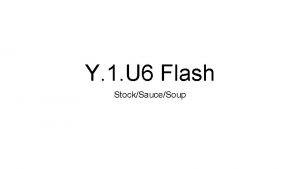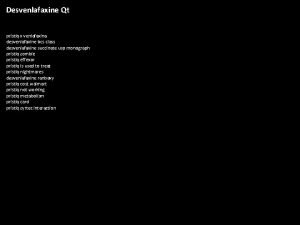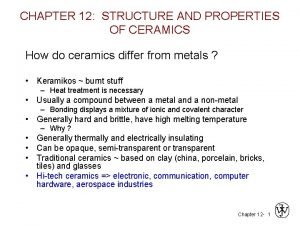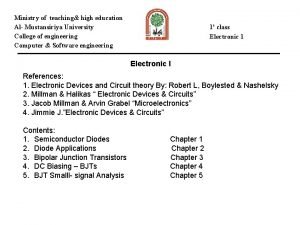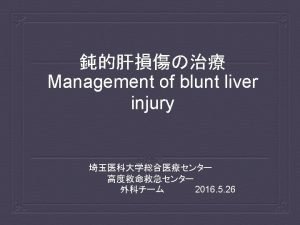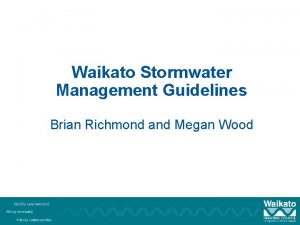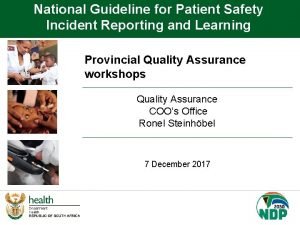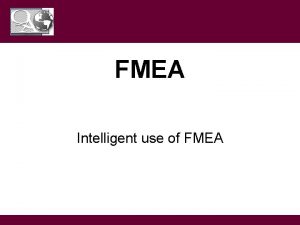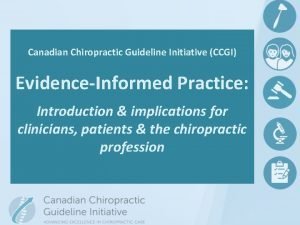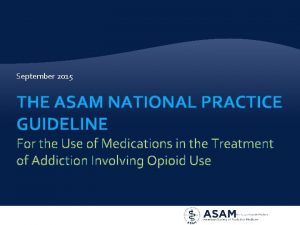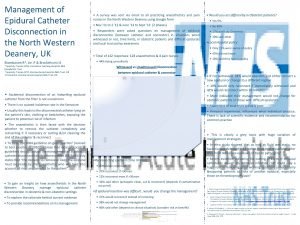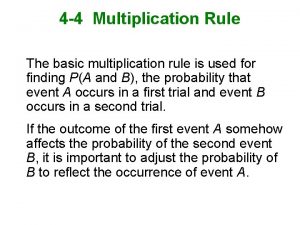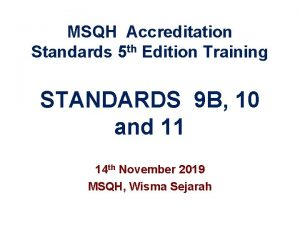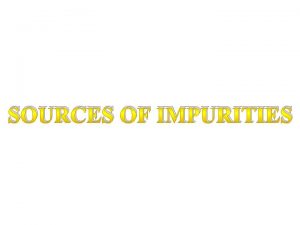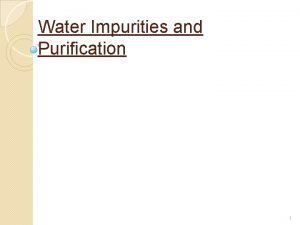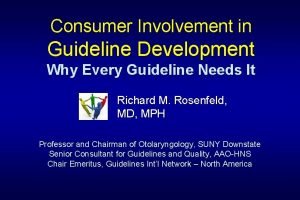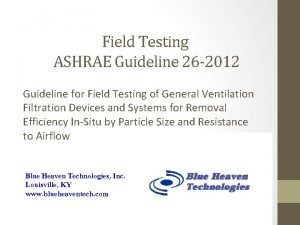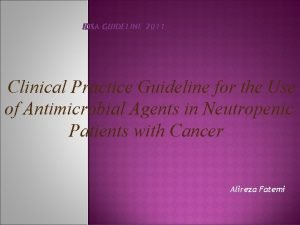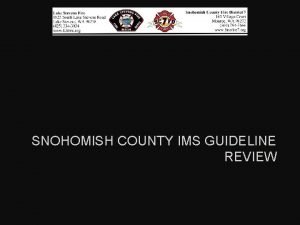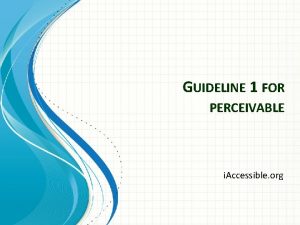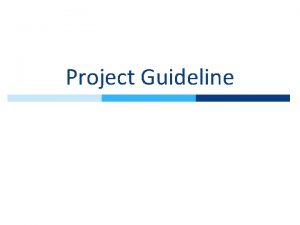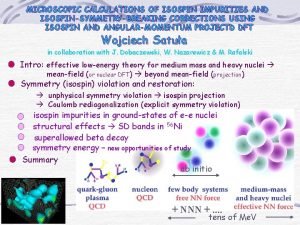GL 11 Impurities Guideline on Impurities in New



















- Slides: 19

GL 11 – Impurities: Guideline on Impurities in New Veterinary Medicinal Products

Disclaimer > These slides have been provided for training purposes only. The presenter has made every attempt to ensure that they are consistent with relevant VICH guideline(s). > As always, the original Guideline(s) should be used as the primary source of information for working with regulators. 2

Quality guidelines on impurities GL 11 is one of the guidelines which belongs to the group of guidelines dealing with impurities: > GL 10 (R) – Impurities in New Veterinary Drug Substances > GL 11 (R) - Impurities in New Veterinary Medicinal Products > GL 18 (R) – Impurities – Residual Solvents in New Veterinary Medicinal Products, Active Substance and Excipients 3

Table of contents > Introduction > Scope > Rationale for reporting and control of impurities > Analytical procedures > Reporting degradation product content of batches > Listing of degradation products in specifications > Qualification of degradation products > Decision Trees 4

Introduction > The objective of GL 11 is to provide guidance for registration applications on the content and qualification of impurities in new veterinary medicinal drug products (VMP) produced from chemically synthesised new drug substances not previously registered in a region or member state. > Alternative approaches may be used. 5

Scope of GL 11 > Only those impurities in new VMP’s classified as degradation product of the drug substance or reaction products of the drug substance with an excipient and/or immediate container > Degradation product: An impurity resulting from a chemical change in the drug substance during manufacture and/or storage of the new VMP > Generally, impurities present in the new drug substance which are not also degradation products, should not be monitored in the new VMP. > This guideline does not apply to VMPs used during clinical research or development > Not in scope: impurities from excipients, extractables and leachables, biological products, peptides, oligonucleatides, radiopharmaceuticals, fermentation products and semi-synthetic products derived from fermentation, herbal products, crude products of animal or plant origin, extraneous contaminants, polymorphic forms and enantiomeric impurities. 6

Identification, reporting and qualification thresholds > Reporting threshold: A limit above (>) which a degradation product should be reported > Identification threshold: A limit above (>) which a degradation product should be identified > Qualification threshold: A limit above (>) which a degradation product should be qualified > Qualification: The process of acquiring and evaluating data that establishes the biological safety of an individual degradation products or a given degradation profile at the levels specified. 7

Identification, reporting and qualification thresholds Identification threshold 1, 0% Reporting threshold 0, 3% Qualification threshold 1, 0% Higher thresholds should be scientifically justified 8

Rationale for the reporting and control of degradation products > The applicant should summarize the degradation products observed during manufacture and/or stability studies of the new VMP. > Additionally, laboratory studies conducted to detect degradation products in new VMP should be summarized. > Summary should include test results of batches manufactured during development and batches representative of the proposed commercial process. > A rationale should be provided for exclusion of those impurities that are not degradation products (i. e. process impurities from the drug substance, impurities arising from excipients. . ) 9

Rationale for the reporting and control of degradation products (cont. ) > Any degradation product observed in stability studies conducted at recommended storage condition should be identified when present at a level above the identification threshold (1, 0%) > When identification is not feasible, a summary of the studies performed should be presented. > Degradation products at a level of not more than the identification threshold (1, 0%) do not need to be identified. • However, analytical procedures should be developed for those degradation products that are suspected to be unusually potent, producing toxic or significant pharmacological effects at levels of not more than the identification threshold (1, 0%) 10

Analytical procedures > Analytical procedures are validated and suitable for the detection and quantification of impurities (see VICH 1 and 2 Guidelines for Analytical Validation) > As appropriate, this validation should include samples stored under relevant stress conditions: light, heat, humidity, acid/base hydrolysis, and oxidation > The quantitation limit for the analytical procedure should be not more than (≤) the reporting threshold (0, 3%) > Organic impurity levels can be measured by a variety of techniques, including those that compare an analytical response for an impurity to that of a reference standard or to the response of the new drug substance itself > Differences between analytical methods used during development and those proposed for registration should be discussed 11

Reporting degradation product content of batches > Analytical results should be provided in the registration application for all relevant batches of the new drug product used for clinical, safety, and stability testing, as well as batches that are representative of the proposed commercial process > Qualitative results should be presented numerically, and not in general terms such as “complies” or “meets limits”, … > Any degradation product above the level of the reporting threshold (0, 3%) should be reported, as well as the total of the degradation products > Results should be reported to one decimal place and rounded using conventional rules > All degradation products above the reporting threshold (0, 3%) should be summed and reported as total impurities 12

Listing of degradation products in specifications > The specification for a new drug product should include a list of degradation products expected to occur during manufacture and under recommended storage conditions. > The selection of degradation products in the new product VMP specifications should be based on the degradation products found in batches manufactured by the proposed commercial process. • A rationale for the inclusion or exclusion of degradation products in the specification should be presented and include a discussion of the impurity profiles observed in the safety and clinical development batches. > Those individual degradation products with specific acceptance criteria included in the new VMP specifications are referred to as “specified degradation products”. • Specified degradation products can be identified or unidentified. > Qualification: The process of acquiring and evaluating data that establishes the biological safety of an individual degradation products or a given degradation profile at the levels specified. 13

Listing of Degradation Products in Specifications (cont. ) > Acceptance criteria should be established by taking into account the acceptance criteria in the drug substance, the qualified level, increase during stability studies, and the proposed shelf life and storage conditions of the new VMP. > Each acceptance criteria should be set no higher than the qualified level of the given degradation product. > Where there is no safety concern, degradation product acceptance criteria should be based on data generated from batches manufactured by the proposed commercial process, allowing sufficient latitude to deal with normal manufacturing and analytical variation and the stability characteristics of the new VMP. 14

Listing of Degradation Products in Specifications (Cont. ) In summary, the new veterinary medicinal product specifications should include, where applicable, the following list of degradation products. > Each specified identified degradation product • Should be included along with specified unidentified degradation products estimated to be present at a level above the identification threshold (1, 0%) > Each specified unidentified degradation product • Should be referred to by an appropriate qualitative analytical descriptive label (e. g. “unidentified A”, unidentified with relative retention of 0, 9”) > Any unspecified degradation with an acceptance criteria of not more than the identification threshold (1, 0%) > Total degradation products • Sum of all degradation products at a level greater than the reporting threshold (0, 3%) 15

Qualification of degradation products > Qualification is the process of acquiring and evaluating data that establishes the biological safety of an individual degradation product or a given degradation profile at the level(s) specified. > The applicant should provide a rationale for establishing degradation product acceptance criteria that includes safety considerations > The level of any degradation product present in a new VMP that has been adequately tested in safety and/or clinical studies would be considered qualified. > Degradation products that are also significant metabolites in animal and/or human studies are generally considered qualified. > Degradation products could be considered qualified at levels higher than those administered in safety studies based on a comparison between actual doses given in the safety study and the intended dose of the new VMP. 16

Qualification of degradation products > If the qualification threshold (1, 0%) is exceeded and data are unavailable to qualify the proposed acceptance criteria of a degradation product, additional studies to obtain such data can be appropriate. > Higher or lower thresholds for qualification of degradation products can be appropriate for some individual new veterinary medicinal products based on scientific rationale and level of concern. • Proposals for alternative thresholds would be considered on a case-by-case basis. > In some cases, reducing the level of degradation product to not more than the threshold can be simpler than providing safety data. • Alternatively, adequate data may be could available in the scientific literature to qualify a degradation product. > Safety testing can be conducted on the new VMP or substance containing the degradation products to be controlled. 17

Decision tree 18

19
 Which grand sauce is made from milk and white roux? *
Which grand sauce is made from milk and white roux? * Desvenlafaxine impurities
Desvenlafaxine impurities Structure and properties of ceramics
Structure and properties of ceramics Trivalent and pentavalent impurities
Trivalent and pentavalent impurities Diffused impurities with five valence electrons are called
Diffused impurities with five valence electrons are called Common solvent impurities
Common solvent impurities Examples of donor impurities
Examples of donor impurities East guideline
East guideline Andreas leischker
Andreas leischker Waikato stormwater management guideline
Waikato stormwater management guideline Elementary statistics chapter 4
Elementary statistics chapter 4 Patient safety incident policy
Patient safety incident policy Fmea guideline
Fmea guideline Canadian chiropractic guideline initiative
Canadian chiropractic guideline initiative Describe the important elements of holding shears
Describe the important elements of holding shears Interview guideline template
Interview guideline template Asam national practice guideline
Asam national practice guideline Disconnected epidural catheter guideline
Disconnected epidural catheter guideline Multiplication rule for 4
Multiplication rule for 4 Msqh standard
Msqh standard
